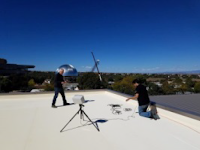Week 6: How Drone Net Works - Hardware Pt. 2 - Mounting and Deployment
Hello Everyone! This week, I began my early spring break, but I have been able to continue analyzing previous drone net tests.
This week , I would like to dive into a discussion of the Drone Net hardware:
This week , I would like to dive into a discussion of the Drone Net hardware:
How does Drone Net's physical design affect its deployability?
The Drone Net system can fit into the form factor of a medium shoe box, making extremely portable. The computer box can mount on most standard-form tripods and needs only two cables to be operated. Additionally, the drone net's weatherproof casing allows the device to remain in use during most weather conditions.
Also, the Drone Net is currently designed to operate on 9.5 Watts while utilizing three cameras. By comparison, the average home computer uses 250 to 500 Watts. The low power consumption allows multiple Drone Net devices to be placed in various locations around a sensitive area. Likewise, the fact that Drone Net is fully automated saves money and time in allocating labor resources. Overall, deployment of the Drone Net is a quick and easy process that requires minimal long-term investment and delivers immediate, accurate results.
Next week, we will discuss the first part of the drone net's software specifications.
Next week, we will discuss the first part of the drone net's software specifications.



Comments
Post a Comment